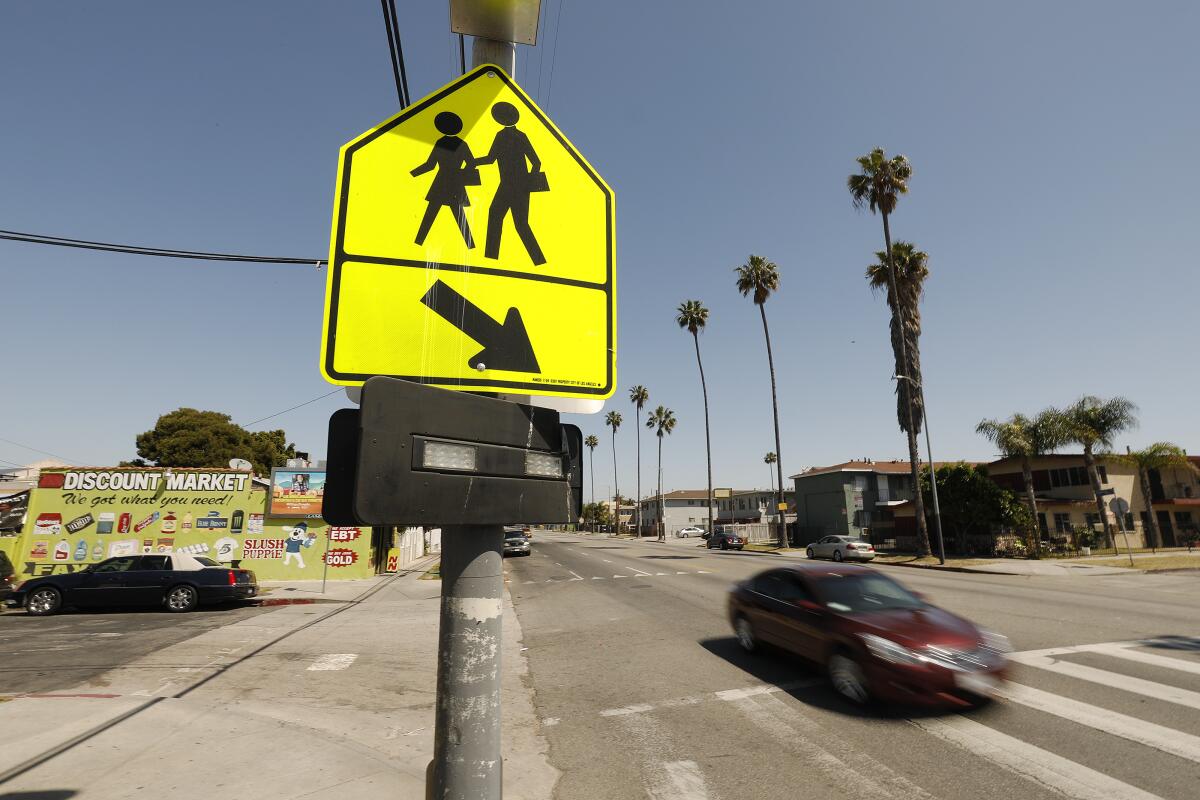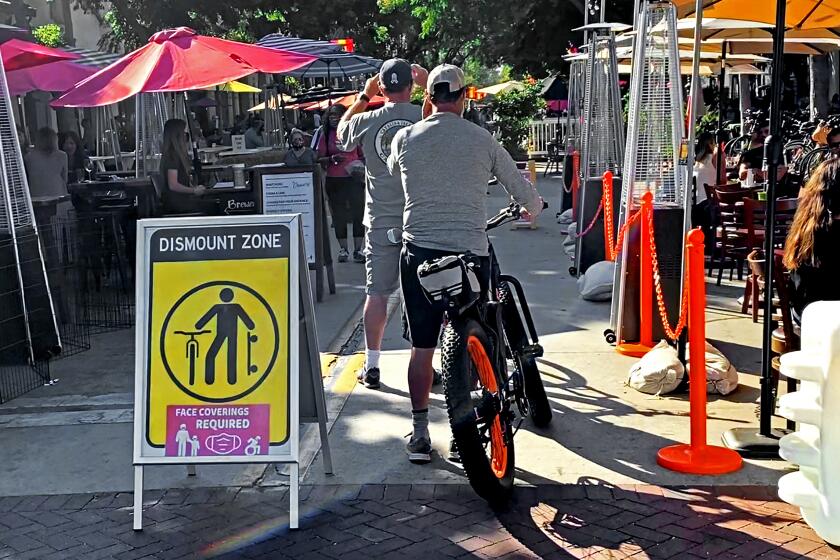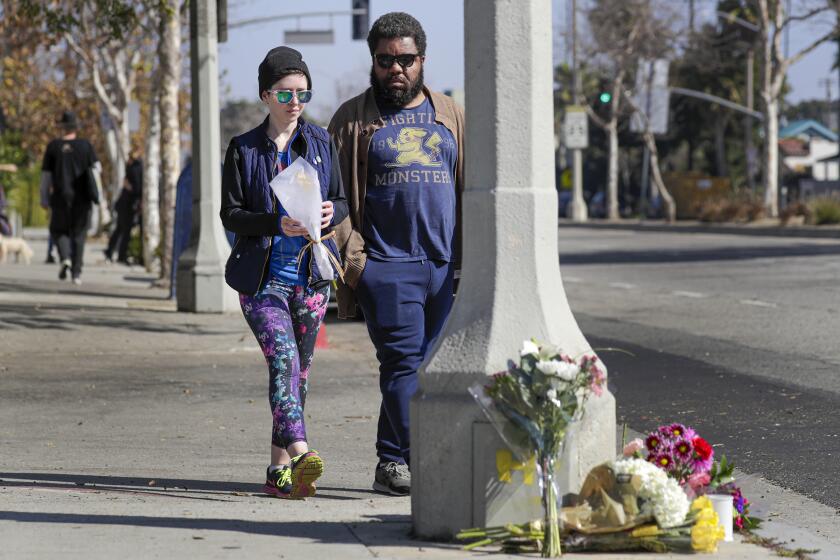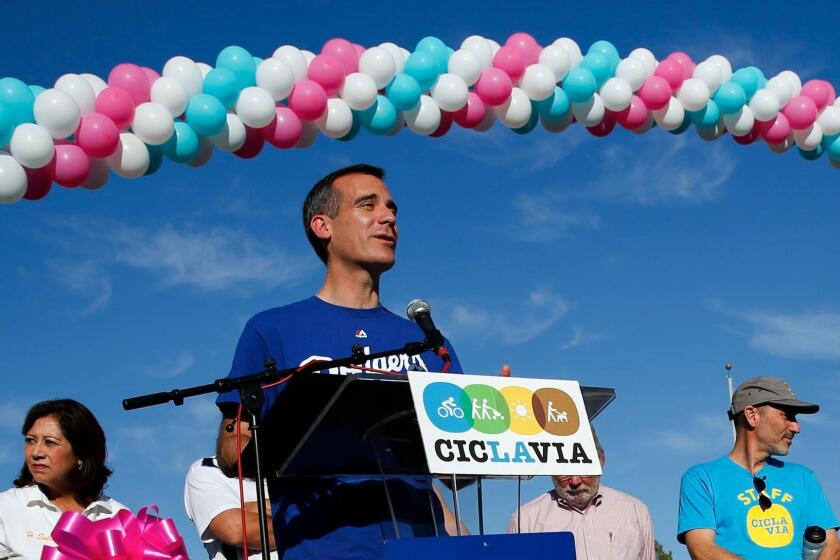Commentary: L.A.âs promise for safer streets has stalled. But a ballot measure could restart the mobility plan

In 2015, the Los Angeles City Council adopted an ambitious new transportation plan that called for adding hundreds of miles of bus-only lanes and protected bike lanes, along with sidewalk and streetscape improvements across the city. The Mobility Plan 2035 was designed to make L.A.âs car-dominated streets safer and more inviting for pedestrians, bicyclists and transit users over 20 years.
It was a huge shift in priority for a city so committed to the car that for decades it focused on relieving congestion and moving motorists as fast as possible. Mayor Eric Garcetti and a majority of the City Council drew national attention for agreeing to sacrifice some car lanes to make room for faster buses and safer cycling and walking.
But, as is so often the case in L.A., the implementation of the Mobility Plan has not matched its ambition.
Since its adoption, the city has only made bike, bus and pedestrian upgrades to 95 miles out of 3,137 miles identified in the plan â or 3% in a little more than six years. Time and again, city leaders have ignored or torpedoed bike and bus lanes outlined in the Mobility Plan. At this rate, it will take nearly 200 years â not 20 â to fulfill the planâs vision.
During the pandemic, cities have turned lightly used streets into pedestrian thoroughfares and parking lots into dining areas. Letâs keep them.
Tired of lobbying the City Council to abide by the Mobility Plan, several transportation and environmental groups have begun collecting signatures for the âHealthy Streets LAâ ballot measure that would force the city to add the promised bus, bike and pedestrian improvements when streets are repaved. The measure would also require the city to create a website tracking the implementation of the Mobility Plan, providing a level of transparency into the city transportation planning bureaucracy that doesnât currently exist.
Going to the voters is the nuclear option, explained Michael Schneider, founder of Streets for All, and an advocate for the street safety improvements outlined in the Mobility Plan.
âWhen I started this work, I thought that data and logic would get the job done,â Schneider said. âI know now that data, logic and charisma are not enough and that we need a forcing function to make it actually happen.â
The entire transportation system, from road engineering to vehicle design, needs to be planned to avoid crashes and to reduce serious injury and death when crashes occur.
Itâs crazy that Angelenos would need to go to the ballot to force the city to implement its own plan. Yet itâs all too common in L.A. for elected officials to adopt visionary, progressive plans and then abandon them when there is the slightest opposition. And thereâs always opposition â itâs the nature of visionary ideas to push people out of their comfort zones.
A longtime observer of city politics once told me that nothing gets done in L.A. without a lawsuit or ballot measure. And thatâs often the case.
Only when the U.S. Department of Justice threatened to sue the city for complete control of the Los Angeles Police Department in the wake of the Rampart corruption scandal in 1999 did the city agree to court-overseen reform of the troubled department. It took a lawsuit by disabled residents to get L.A. to finally start fixing decades of broken sidewalks. And the cityâs wildly successful Transit Oriented Communities incentive program, through which 41,000 units of housing have been proposed, including more than 8,800 affordable units, wasnât created by the City Council. It was the result of Measure JJJ ballot initiative in 2016.
When city leaders pass a plan, they prefer to give themselves loopholes and exit strategies because, well, politics and policy can be hard. Some in City Hall have noted that the Mobility Plan was adopted as an aspirational document, not an ordinance or a binding commitment. It was a vision for how the city could build, not how it would build.
Itâs no secret that Los Angeles has some of the most dangerous streets in America.
Sure, there needs to be some flexibility in how the city implements a 20-year plan, particularly when most Angelenos donât participate in wonky long-term transportation planning policy workshops.
âWe need to be mindful that we donât unintentionally strip communities, especially those who have historically been left out of the conversation, from having a say in what investments best fit the needs of their neighborhoods,â warned Seleta Reynolds, general manager of the Department of Transportation.
The need for community engagement canât be an excuse for doing nothing. Thereâs too much at stake. Last year nearly 300 people were killed in traffic collisions in Los Angeles, a roughly 20% increase over the two prior years. Nearly half of the people killed were pedestrians. Some 52% of Angelenos said that crossing the street in their neighborhood is dangerous, according to polling conducted for the Healthy Streets LA initiative.
As part of his Green New Deal sustainability plan â another aspirational document â Garcetti called for 50% of all trips in the city by 2035 to be made by walking, biking and taking transit. But that goal will be unreachable without the political will to prioritize the infrastructure and transit improvements that make it easier, safer and more pleasant for people to get around.
It shouldnât take a ballot measure or a lawsuit for Los Angeles leaders to follow through on their commitments to a healthier, safer future. Thereâs nothing stopping the City Council from passing its own ordinance requiring city departments to build the improvements laid out in the Mobility Plan. Nothing except political will.
More to Read
A cure for the common opinion
Get thought-provoking perspectives with our weekly newsletter.
You may occasionally receive promotional content from the Los Angeles Times.














